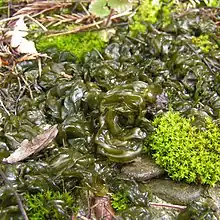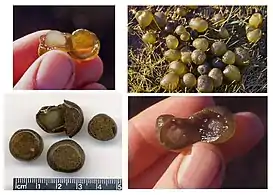Nostoc
Nostoc, also known as star jelly, troll’s butter, spit of moon, fallen star, witch's butter (not to be confused with the fungi commonly known as witches' butter), and witch’s jelly, is the most common genus of cyanobacteria found in a variety of both aquatic and terrestrial environments that may form colonies composed of filaments of moniliform cells in a gelatinous sheath of polysaccharides.[1] It may also grow symbiotically within the tissues of plants, providing nitrogen to its host through the action of terminally differentiated cells known as heterocysts. Nostoc is a genus that includes many species that are diverse in morphology, habitat distribution, and ecological function.[2] Nostoc can be found in soil, on moist rocks, at the bottom of lakes and springs, and rarely in marine habitats. It may also be found in terrestrial temperate, desert, tropical, or polar environments.[3]
| Nostoc | |
|---|---|
 | |
| Nostoc commune | |
| Scientific classification | |
| Domain: | Bacteria |
| Phylum: | Cyanobacteria |
| Class: | Cyanophyceae |
| Order: | Nostocales |
| Family: | Nostocaceae |
| Genus: | Nostoc Vaucher, 1888, ex Bornet and Flahaul |
| Species | |
|
List
| |
The name Nostoc was coined by Paracelsus and is a combination of the English nostril and German Nasenloch "nose hole, nostril", likely due to appearance of many species colonies being similar to nasal mucus.[4] When it is on the ground, a Nostoc colony is ordinarily not seen, but after a rain, it swells up into a conspicuous, jellylike mass, which was once thought to have fallen from the sky, hence the popular names, like star jelly, troll’s butter, and witch's butter mentioned above.
Morphology
_Figure_2.jpg.webp)
Nostoc are a genus of Gram-negative photosynthetic cyanobacteria.[1] Many species of Nostoc possess an outer layer and extensive inner matrix of polysaccharides, giving them their "jelly-like" or gelatinous appearance, and also help to protect them from their environment and can assist in the absorption of moisture. This allows them to survive stressful conditions such as fluctuating temperatures, drought, salt stress, desiccation, UV radiation, and infection by pathogens.[2][5] Some species within the genus also have nitrogen-fixing heterocyst filaments enclosed in this membrane.[2]
Many members of the Nostoc genus form colonies. These colonies can reach several centimeters in diameter.[5] These colonies consist of mats or gelatinous masses created by aggregated trichomes that can appear in a range of colors (depending on the species) such as brown, yellow, or green.[3]
Additionally, some species of Nostoc are able to enter quiescent stages, further aiding in their survival of adverse conditions, and allowing them to resume metabolism when re-hydrated.[2]
Ecology
Habitat and distribution
Nostoc can be found in a variety of environments, both terrestrial and aquatic, depending on the species. Their polysaccharide outer layer and matrix allows them to survive and thrive in a variety of conditions and habits ranging from deserts, semideserts, grasslands, polar, and tropical regions depending on the particular species of Nostoc.[2][5] In terms of aquatic environments, Nostoc has been documented to be naturally found in marine water, fresh water, as well as brackish water.[1]


Interactions with other organisms
Depending on the species, Nostoc may either be free-living in their environment, or they may form relationships with the other organisms in their environment, such as plants, fungi, or other bacteria.[2] Because Nostoc is able to form colonies on the surface of bare minerals, it is able to provide a more stable environment for higher vegetation in its environment.[2] Some species of Nostoc also form relationships with plants that lack vascular tissue such as Bryophytes because of their ability to fix nitrogen. Nostoc has also been found to form symbiotic associations and other relationships with other bacteria in their environment. Some species of Nostoc that form colonies in freshwater environments provide a habitat to other freshwater bacteria. Additionally, some species like N. commune and N. flageliforme form relationships with heterotrophic bacteria and actinobacteria present in their environments, likely due to the fact that they are a potential significant player in nitrogen cycling in aquatic ecosystems.[5]
Usage
Biotechnological usage
Nostoc has been documented to produce many compounds of interest, including those that are antiviral, antitumor, antifungal, and antibacterial.[6][1]
In addition to the suggested pharmaceutical usage, Nostoc has also been a suggested biofertilizer, and source of fatty acids for biofuel production.[1][7]
Environmental usage
Nostoc has the unique ability to survive and colonize new and bare mineral surfaces by moss and other higher plants, which then allows for more organic soil and stable vegetation. It has been suggested that Nostoc be used in environments of retreating glaciers in order to establish new and more stable presences of vegetation on newly exposed mineral surfaces.[2]
Historical and culinary usage
Nostoc has historically been utilized as a healthy food and traditional medicine, most notably in Asia [8] Historically, the species N. flagelliforme and N. commune have been consumed in China, where it was used to survive famines and has been used as an ingredient in Chinese medicine since the Eastern Jin Dynasty.[8] Additionally, Nostoc has had documented culinary usage in India, Indonesia, Peru, Bolivia, and Ecuador.[1]
Nostoc is also highly nutritious, containing protein and vitamin C,[9] as well as all essential amino acids.[1] It has been suggested to be anti-inflammatory and an antioxidant as well.[8] Because of this, Nostoc has also been considered to be a strong candidate for extraterrestrial agriculture.[1]
Human impact and management

Because of human foot traffic, and contaminated gardening tools and irrigation systems, Nostoc is usually found outside of its natural habitat in plant nurseries and greenhouses. A number of different control methods can be effective in removing unwanted Nostoc from these environments, including implementing increased drainage in these facilities, physical removal of Nostoc, and flame weeders or solarization.[3]
Taxonomy
Nostoc is a member of the family Nostocaceae of the order Nostocales. Species include (see collapsed list on the right for full listing) :
- Nostoc azollae
- Nostoc caeruleum Lyngbye ex Bornet et Flahault[10]
- Nostoc carneum
- Nostoc comminutum
- Nostoc commune (Linnaeus) Vaucher ex Bornet et Flahault[10] (Chinese: Koxianmi)[11]
- Nostoc ellipsosporum
- Nostoc flagelliforme
- Nostoc linckia
- Nostoc longstaffi
- Nostoc microscopicum (Carmichael ex Harvey) Bornet et Flahault[10]
- Nostoc muscorum
- Nostoc paludosum
- Nostoc pruniforme (Linnaeus) C. A. Agardh ex Bornet et Flahault[10]
- Nostoc punctiforme
- Nostoc sphaericum
- Nostoc sphaeroides
- Nostoc spongiaeforme
- Nostoc thermotolerans
- Nostoc verrucosum Vaucher ex Bornet et Flahault[10]
References
Citations
- Fidor, Anna; Konkel, Robert; Mazur-Marzec, Hanna (2019-09-29). "Bioactive Peptides Produced by Cyanobacteria of the Genus Nostoc: A Review". Marine Drugs. 17 (10): 561. doi:10.3390/md17100561. ISSN 1660-3397. PMC 6835634. PMID 31569531.
- Sand-Jensen, Kaj (July 2014). "Ecophysiology of gelatinous Nostoc colonies: unprecedented slow growth and survival in resource-poor and harsh environments". Annals of Botany. 114 (1): 17–33. doi:10.1093/aob/mcu085. ISSN 1095-8290. PMC 4071103. PMID 24966352.
- "SS-AGR-431/AG430: Biology and Management of Nostoc (Cyanobacteria) in Nurseries and Greenhouses". edis.ifas.ufl.edu. Retrieved 2022-04-24.
- Potts, M. (1997). "Etymology of the Genus Name Nostoc (Cyanobacteria)" (PDF). International Journal of Systematic Bacteriology. 47 (2): 584. doi:10.1099/00207713-47-2-584. Archived (PDF) from the original on 2013-08-11. Retrieved 2011-11-05.
- Aguilar, Pablo; Dorador, Cristina; Vila, Irma; Sommaruga, Ruben (2019). "Bacterial Communities Associated With Spherical Nostoc Macrocolonies". Frontiers in Microbiology. 10: 483. doi:10.3389/fmicb.2019.00483. ISSN 1664-302X. PMC 6437075. PMID 30949138.
- Nowruzi, Bahareh; Haghighat, Setareh; Fahimi, Hossein; Mohammadi, Ehsan (March 2018). "Nostoc cyanobacteria species: a new and rich source of novel bioactive compounds with pharmaceutical potential". Journal of Pharmaceutical Health Services Research. 9 (1): 5–12. doi:10.1111/jphs.12202. S2CID 80405030.
- Bhandari, Rupali; Sharma, Prabhat Kumar (2006). "High-light–induced Changes on Photosynthesis, Pigments, Sugars, Lipids and Antioxidant Enzymes in Freshwater (Nostoc spongiaeforme) and Marine (Phormidium corium) Cyanobacteria". Photochemistry and Photobiology. 82 (3): 702–710. doi:10.1562/2005-09-20-ra-690. ISSN 0031-8655. PMID 16464127. S2CID 24222149.
- Li, Zhuoyu; Guo, Min (2018). "Healthy efficacy of Nostoc commune Vaucher". Oncotarget. 9 (18): 14669–14679. doi:10.18632/oncotarget.23620. PMC 5865699. PMID 29581873.
- Deane, Green (2011-08-31). "Nostoc Num Nums". Eat The Weeds and other things, too. Archived from the original on 2019-01-31. Retrieved 2019-02-20.
- Mollenhauer, Dieter; Bengtsson, Roland; Lindstrøm, Eli-Anne (1999). "Macroscopic cyanobacteria of the genus Nostoc: a neglected and endangered constituent of European inland aquatic biodiversity". European Journal of Phycology. 34 (4): 349–360. doi:10.1080/09670269910001736412.
- Abbott, I. A. (1989). "Food and food products from seaweeds". In Lembi, C. A.; Waaland, J. R. (eds.). Algae and human affairs. Cambridge University Press, Phycological Society of America. p. 141. ISBN 978-0-521-32115-0.
General sources
- "Nikon MicroscopyU: Confocal Image Gallery - Nostoc (Cyanobacteria)". 9 March 2005. Archived from the original on 2005-03-09. Retrieved 15 January 2019.
- Office, NOAA Sea Grant Extension. "GLERL/Sea Grant: Great Lakes Water Life Photo Gallery - Blue-green Algae - Cyanophtya". www.glerl.noaa.gov. Archived from the original on 2019-02-20. Retrieved 2019-02-20.
- Davidson, Alan. Oxford Companion to Food (1999), "Nostoc". ISBN 0-19-211579-0
External links
- "Aktuelle News, Schlagzeilen und Berichte aus aller Welt - Arcor.de". www.arcor.de. Retrieved 15 January 2019. Nostoc spec. in lichens
- Guiry, M.D.; Guiry, G.M. "Nostoc". AlgaeBase. World-wide electronic publication, National University of Ireland, Galway.
